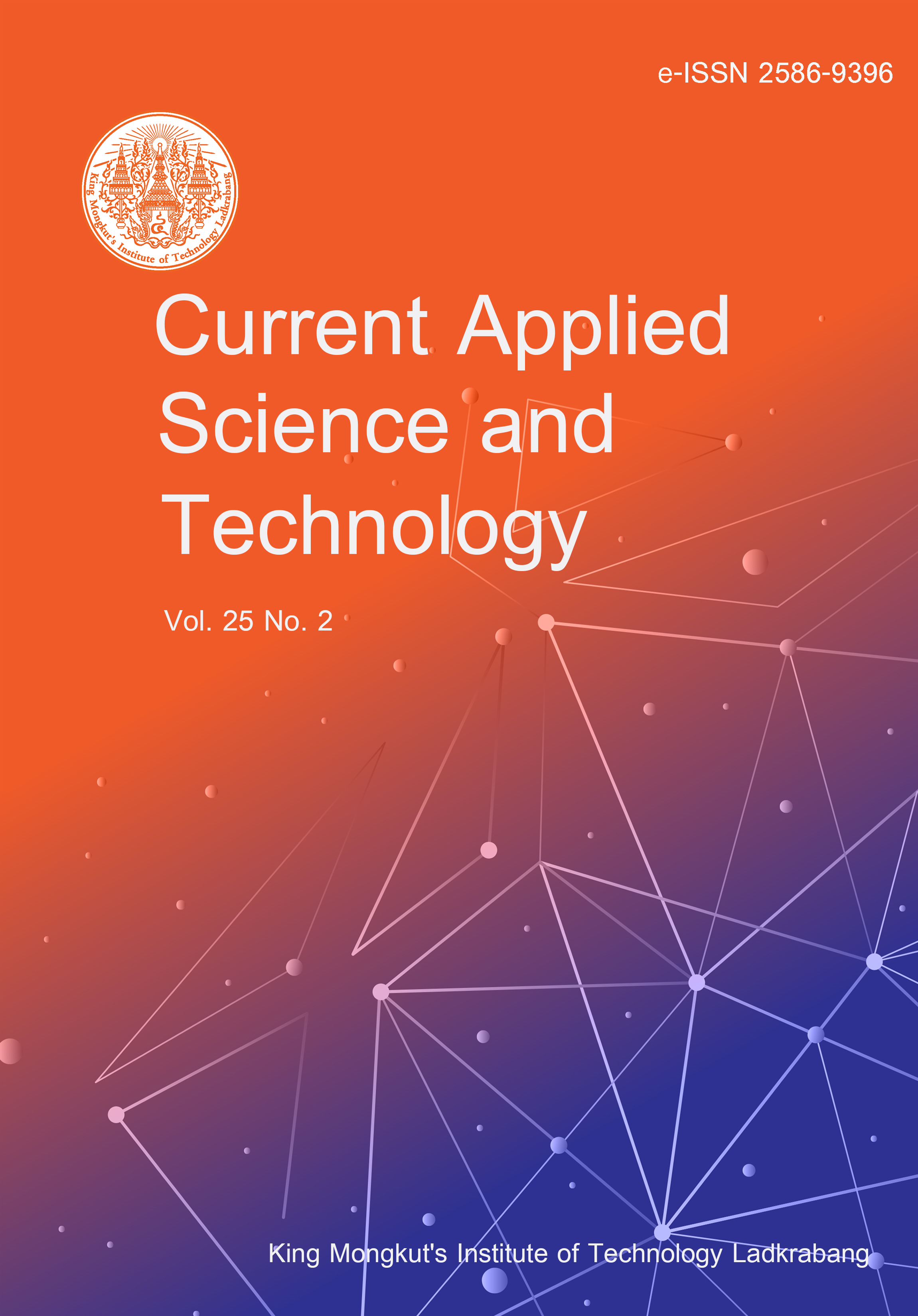Chromolaena odorata Extract as an Eco-Friendly Reducing Agent for Graphene Oxide
Main Article Content
Abstract
Chromolaena odorata (Siam weed) was researched for its application as a novel reducing agent. Graphene oxide (GO) was prepared via a modified Hummers method, and its reduction was achieved using an aqueous extract of Chromolaena odorata leaves. The use of conventional reducing agents typically results in hydrophobic reduced graphene oxide (rGO), which leads to agglomeration in solvents. However, the green reduction method using Chromolaena odorata extract achieved a homogeneous dispersion, which is crucial for applications requiring simple preparation techniques such as magnetic stirring, ultrasonic sonication, and vacuum mixing. Characterization of the rGO revealed a broad peak around 24.12º in the x-ray diffraction (XRD) pattern, an increased ID / IG ratio of 1.09 from Raman spectroscopy, and a high C:O ratio of 5.07 from energy dispersive x-ray spectroscopy (EDS). Additionally, BET analysis demonstrated an increase in surface area and pore volume, while FESEM analyses showed a uniform morphology with clear structural defects and minimal oxygen content. FTIR spectra further confirmed the reduction process, indicated significant decrease in oxygen-related peaks. These findings highlight the potential of Chromolaena odorata as a sustainable reducing agent for the environmentally friendly synthesis of high-quality rGO.
Article Details

This work is licensed under a Creative Commons Attribution-NonCommercial-NoDerivatives 4.0 International License.
Copyright Transfer Statement
The copyright of this article is transferred to Current Applied Science and Technology journal with effect if and when the article is accepted for publication. The copyright transfer covers the exclusive right to reproduce and distribute the article, including reprints, translations, photographic reproductions, electronic form (offline, online) or any other reproductions of similar nature.
The author warrants that this contribution is original and that he/she has full power to make this grant. The author signs for and accepts responsibility for releasing this material on behalf of any and all co-authors.
Here is the link for download: Copyright transfer form.pdf
References
Alwan, S. H., Omran, A. A., Naser, D. K., & Ramadan, M. F. (2023). A mini-review on graphene: Exploration of synthesis methods and multifaceted properties. Engineering Proceedings, 59(1), Article 226. https://doi.org/10.3390/engproc2023059226
Anuwongsa, N., Yawai, T., & Ananpreechakorn, W. (2023). A simple preparation of graphene oxide with a modified Hummer's method. Journal of Materials Science and Applied Energy, 12(3), Article 251664. https://doi.org/10.55674/jmsae.v12i3.251664
Balandin, A. A., Ghosh, S., Bao, W., Calizo, I., Teweldebrhan, D., Miao, F., & Lau, C. N. (2008). Superior thermal conductivity of single-layer graphene. Nano Letters, 8(3), 902-907. https://doi.org/10.1021/nl0731872
Eda, G., Lin, Y.-Y., Mattevi, C., Yamaguchi, H., Chen, H.-A., Chen, I.-S., Chen, C.-W., & Chhowalla, M. (2010). Blue photoluminescence from chemically derived graphene oxide. Advanced Materials, 22(4), 505-509. https://doi.org/10.1002/adma.200901996
Lawal, A. T. (2019). Graphene-based nanocomposites and their applications: A review. Biosensors and Bioelectronics, 141, Article 111384. https://doi.org/10.1016/j.bios.2019.111384
Lee, C., Wei, X., Kysar, J. W., & Hone, J. (2008). Measurement of the elastic properties and intrinsic strength of monolayer graphene. Science, 321(5887), 385-388. https://doi.org/10.1126/science.1157996
Liang, F. X., Gao, Y., Xie, C., Tong, X. W., Li, Z. J., & Luo, L. B. (2018). Recent advances in the fabrication of graphene-ZnO heterojunctions for optoelectronic device applications. Journal of Materials Chemistry C, 6(17), 3815-3833. https://doi.org/10.1039/C8TC00172C
Mahbubul, M. T. H., Saidur, R., & Metselaar, H. S. C. (2016). The green reduction of graphene oxide. RSC Advances, 6, 27807-27828. https://doi.org/10.1039/C6RA03189G
Pei, S., Zhao, J., Du, J., Ren, W., & Cheng, H.-M. (2012). Direct reduction of graphene oxide films into highly conductive and flexible graphene films by hydrohalic acids. Carbon, 50(12), 3210-3215. https://doi.org/10.1016/j.carbon.2010.08.006
Tarcan, R., Todor-Boer, O., Petrovai, I., Leordean, C., Astilean, S., & Botiz, I. (2020). Reduced graphene oxide today. Journal of Materials Chemistry C, 8(4), 1198-1224. https://doi.org/10.1039/C9TC04916A
Tene, T., Tubon Usca, G., Guevara, M., Molina, R., Veltri, F., Arias, M., Caputi, L. S., & Vacacela Gomez, C. (2020). Toward large-scale production of oxidized graphene. Nanomaterials, 10(2), Article 279. https://doi.org/10.3390/nano10020279
Wang, G. X., Shen, X. P., Wang, B., Yao, J., & Park, J. (2009). Synthesis and characterisation of hydrophilic and organophilic graphene nanosheets. Carbon, 47, 1359-1364. https://doi.org/10.1016/j.carbon.2009.01.027
Zhu, Y., Murali, S., Cai, W., Li, X., Suk, J. W., Potts, J. R., & Ruoff, R. S. (2010). Graphene and graphene oxide: Synthesis, properties, and applications. Advanced Materials, 22(35), 3906-3924. https://doi.org/10.1002/adma.201001068






